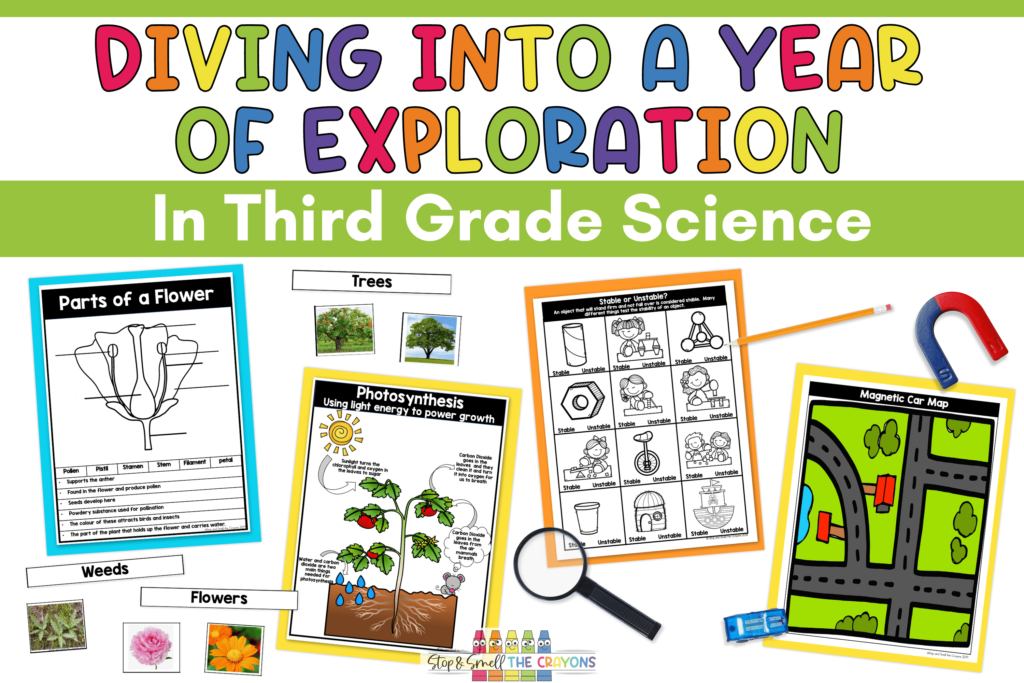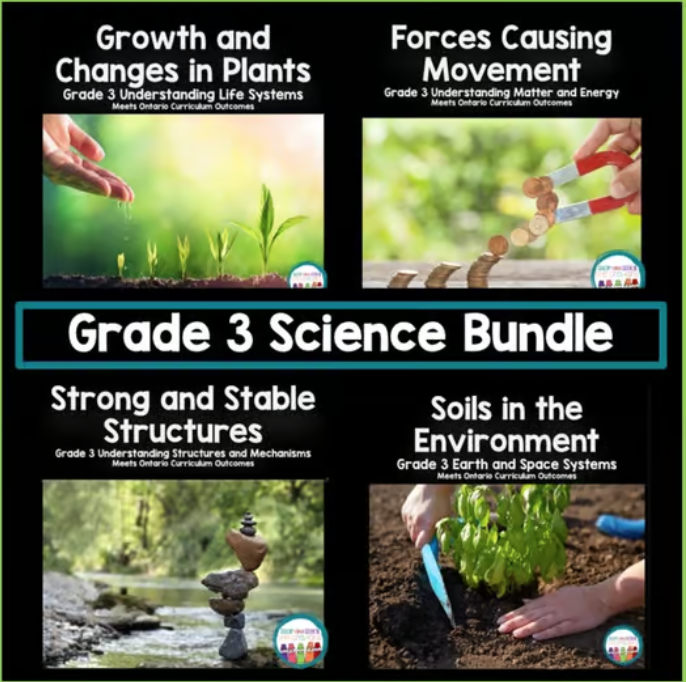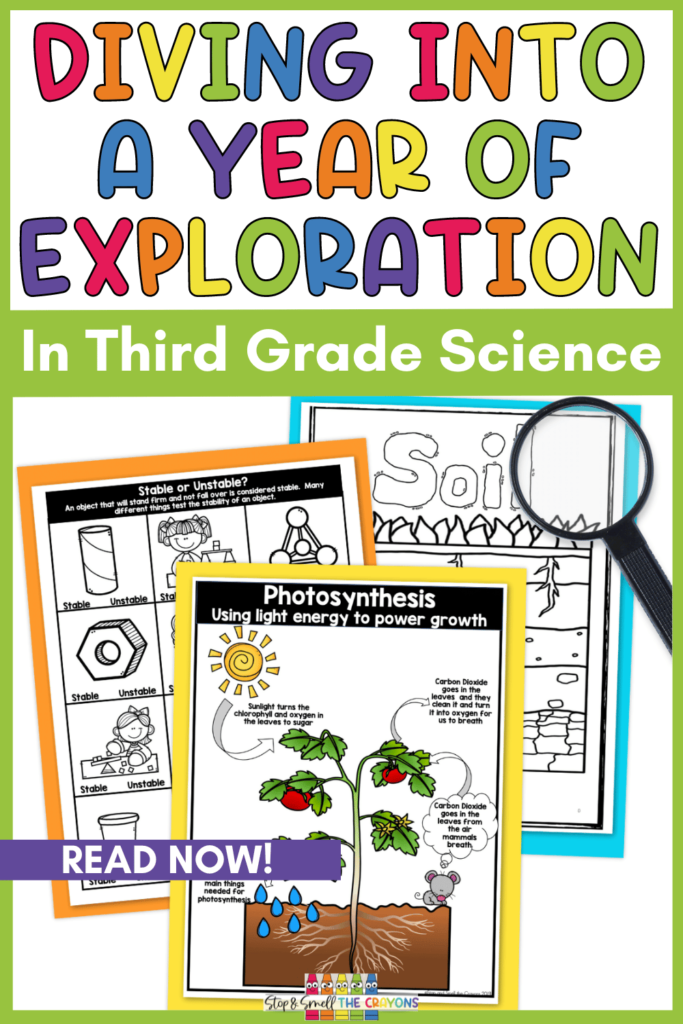Third graders are such eager learners! It’s one of the many things I absolutely love about working with this age group. When it comes to third grade science, there are countless fun and hands-on ways to explore different topics. The more interactive the learning, the better! Today, I’m excited to walk you through my Third Grade Science bundle, which will help you plan your science lessons for the entire year!

Reasons a Quality Third Grade Science Curriculum is Needed

Third grade science is such an important subject to teach! This is the age when kids’ natural curiosity about the world around them is at its peak. They’re full of questions and ready to explore. Teaching science in third grade taps into that curiosity. It helps them start understanding the basic principles of how things work.
Plus, it’s the perfect time to introduce them to scientific thinking. They learn how to ask questions, make observations, and draw conclusions. These skills are not only essential for science but are also valuable life skills. It’s also a blast watching their faces light up during experiments and hands-on activities. By making science fun and engaging at this age, we’re setting the foundation for a lifelong love of learning and discovery.
Units in the Third Grade Science Bundle
My third grade science bundle has four exciting units that I can’t wait to share with you. We’ve got a unit on soils in the environment, one on strong and stable structures, another on forces causing movement, and a unit on growth and changes in plants. Each unit is packed with everything you need: worksheets, full-color slides, hands-on activities, experiments, task cards, vocabulary cards, posters, charts, and more! Let’s break each unit down to learn more!
Life Science: Growth and Changes in Plants
I’m so excited to take you through my third grade science unit on growth and changes in plants! This unit covers everything from plant life cycles and basic needs to photosynthesis and beyond. It’s designed to give your students a comprehensive understanding of plant growth and change.

To kick things off, I love setting the stage with a read-aloud and an interactive activity displayed on a Smartboard. These digital interactive activities are perfect for introducing each lesson in a fun and engaging way. Plus, I’ve included a preassessment to gauge what my students already know and to identify any misconceptions they might have.
The unit also includes reading comprehension articles with review questions or activities, which help reinforce what we’ve covered in class. It’s the hands-on experiments that really bring the lessons to life. These experiments allow my students to apply what they’ve learned, making the concepts tangible and memorable.
Real-life photos are sprinkled throughout the unit, helping students visualize the different parts of plants, types of leaves, and stages of the life cycle. For those early finishers or during independent work time, I’ve got a packet of additional activities like word searches, crosswords, and drawing and labeling forest scenes. This keeps everyone engaged and learning, no matter how quickly they work through the main activities.
For more ways to add to your unit, check out 5 Hands-On Activities to Teach Growth and Changes in Plants.
Earth and Space: Soils in the Environment
The next unit in the bundle is all about the soils in the environment! This engaging unit helps your students understand the vital role soil plays in our world. We’ll cover everything from the different types of soil to roots, compost, erosion, and so much more!

We start the unit by brainstorming all the ways soil is important. I create a chart and gather my students’ ideas about how soil is crucial for humans, animals, plants, and even for general uses like building. This sets the stage for our exploration into what makes up soil.
Each student gets a soil sample, which they can either bring from home or use ones I’ve pre-collected. They have a blast using magnifying glasses to examine the soil up close, noting its different characteristics. They’ll use their senses to make observations through touch, feel, smell, and even infer about taste! It’s always a hit.
I recommend engaging videos that explain soil composition at a third-grade level within the unit. We read a passage about soil and answer some questions to reinforce their understanding. Then, we get active! The students move around the room to visit posters that describe different types of soil.
The unit includes a variety of experiments, from observing different soil samples and separating soil components to testing how well different soils absorb water. We even explore how various soil types impact plant growth! These hands-on activities make learning about soil exciting and memorable for my students.
To learn more about how to teach about soils in the environment, make sure to read 5 Activities for Teaching Soils in the Environment.
Matter and Energy: Forces Causing Movement
The third unit in the bundle is all about forces causing movement, which may be one of my favorite third grade science units! Your little scientists will dive into friction, push/pull, muscular force, gravity, forces of nature, magnetic force, static force, and so much more.

I love using a variety of read-alouds in this unit, so I’ve created a page with multiple recommendations to get you started. To help students connect what they read to actual motion, I bring in YouTube videos that show forces in action. This makes the concepts come alive for them. I also make vocabulary wall anchor charts for important terms, which help to reinforce their learning.
Each lesson includes an interactive component that can be displayed on the Smartboard, giving students a chance to actively participate. The hands-on experiments are always a hit! They use magnets to test which materials are magnetic and see how long a chain of paperclips they can pick up with a magnet. One of the students’ favorites is the Magnet Map activity. Students create a map with different buildings and streets, then guide a toy car around their town using a magnet. It’s so much fun!
Another popular experiment is the static electricity balloon activity. Each student blows up a balloon and rubs it on their head to see how well their hair stands up. We also do other static electricity experiments with Styrofoam, salt, and pepper. To test out muscular force, students have a mini workout session, which they love. To top it all off, we recreate forces of nature like a tornado or a volcano with exciting experiments!
For even more activities, explore Fun and Engaging Activities for Teaching Forces Causing Movement.
Structures and Mechanisms: Strong and Stable Structures
The last unit is all about strong and stable structures! This unit covers topics that teach students how architects plan and build structures. Your students will learn about the components of structures through hands-on experiments, building challenges, worksheets, and center activities. I provide vocabulary posters, suggested video links, and book recommendations to help you design these lessons in the best way for your students.

One of the first experiments involves using tubes to see which one is the strongest and can hold different types of weight. We use simple items like cardboard and folded paper to test how sturdy or weak a structure is with amounts of weight. Another experiment involves bridge building! My students absolutely love this one! They get to move around furniture and use materials like straws, toothpicks, and cardboard to create their bridges.
When we explore levers, my students are always amazed at how many they use without even realizing it. For the lever experiment, they work on their prediction and testing skills to see how many pennies it takes to lift a certain amount. To learn about balancing, we head to the gym or go outside for this activity. I use task cards to read off different balancing challenges, and the kids have a blast testing their balancing abilities.
We also look at the different structures around us, both man-made and natural. I use real-life photos of famous places around the world to show various buildings and bridges. I made those photos into posters that can be displayed on your focus wall or in your classroom! Learn more about 5 Creative Ways to Teach Strong and Stable Structures.
Third Grade Science Bundle Makes Planning Easy
I hope you’re as excited as I am about the possibilities my Third Grade Science bundle offers! In it, you get all four of these units and the already prepared lessons and activities. All you have to do is download, print, and teach!

With engaging, hands-on activities and comprehensive lessons, teaching science has never been more fun or effective. From exploring plant life cycles and soil composition to understanding forces and building strong structures, this bundle covers it all. It’s designed to spark curiosity, encourage scientific thinking, and make learning an adventure for your third graders!
Save for Later
Remember to save this post to your favorite teacher Pinterest board for when you’re planning your third grade science units!
